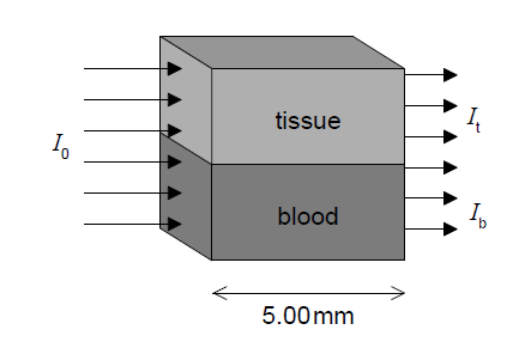Question
An X-ray beam, of intensity $I_0$, is used to examine the flow of blood through an artery in the leg of a patient. The beam passes through an equal thickness of blood and soft tissue.

The thickness of blood and tissue is $5.00 \mathrm{~mm}$. The intensity of the X-rays emerging from the tissue is $I_{\mathrm{t}}$ and the intensity emerging from the blood is $I_{\mathrm{b}}$. The following data are available.
$
\begin{array}{ll}
\text { Mass absorption coefficient of tissue } & =0.379 \mathrm{~cm}^2 \mathrm{~g}^{-1} \\
\text { Mass absorption coefficient of blood } & =0.385 \mathrm{~cm}^2 \mathrm{~g}^{-1} \\
\text { Density of tissue } & =1.10 \times 10^3 \mathrm{~kg} \mathrm{~m}^{-3} \\
\text { Density of blood } & =1.06 \times 10^3 \mathrm{~kg} \mathrm{~m}^{-3}
\end{array}
$
a(i)Show that the ratio $\frac{I_{\mathrm{b}}}{I_{\mathrm{t}}}$ is close to 1 .
a(ii)State and explain, with reference to you answer in (a)(i), what needs to be done to produce a clear image of the leg artery using X-rays.[4]
b. In nuclear magnetic resonance (NMR) protons inside a patient are made to emit a radio frequency electromagnetic radiation. Outline the
mechanism by which this radiation is emitted by the protons.[3]
▶️Answer/Explanation
Ans:
$
\begin{aligned}
\mathrm{a}(\mathrm{i}) \mu_{\mathrm{t}} & =0.379 \times 1.1 \times 10^3 \times \frac{10^3}{10^6}=0.417 \ll \mathrm{cm}^{-1} » \text { AND } \mu_{\mathrm{b}}=0.408 \ll \mathrm{cm}^{-1} » \\
\frac{I_{\mathrm{b}}}{I_{\mathrm{t}}} & =\frac{I_0 e^{-\mu_{\mathrm{b}} x}}{I_0 e^{-\mu_{\mathrm{t}} x}}=e^{-(0.408-0.417) \times 0.5} \checkmark \\
\frac{I_{\mathrm{b}}}{I_{\mathrm{t}}} & =1.004 \checkmark
\end{aligned}
$
a(iithe difference between intensities is negligible so no contrast
modifying the blood is easier than modifying the soft tissue
increase absorption of $\mathrm{X}$-rays in the blood
by injecting/introducing a liquid/chemical/contrast medium
with large mass absorption coefficient/nontoxic/higher density
b. «a uniform» magnetic field is applied to align proton spins
proton spins are excited by an «external» radio frequency signal/field
OR
protons change from spin-up to spin-down state due to «external» RF signal/field
«radio frequency» radiation is emitted as the protons relax
NOTE: For MP3 do not allow simplistic “protons emit RF radiation” as this is given in the question
Question
a. Outline how ultrasound, in a medical context, is produced.[2]
b. Suggest the advantage in medical diagnosis of using ultrasound of frequency $1 \mathrm{MHz}$ rather than $0.1 \mathrm{MHz}$.[2]
c. Ultrasound can be used to measure the dimensions of a blood vessel. Suggest why a B scan is preferable to an A scan for this application.$[2]$
▶️Answer/Explanation
Ans:
a. mention of AC voltage $O R$ to piezo-electric crystal
crystal vibrates «at its resonant frequency»
b. $1 \mathrm{MHz}$ waves have shorter wavelength than $0.1 \mathrm{MHz}$
can probe smaller size areas of organs/have higher resolution
c. a B scan is a computer generated combination of a large number of A scans
allowing a measurement in different directions/two dimensional image